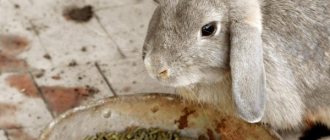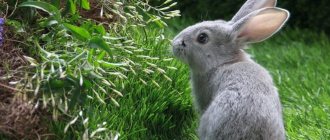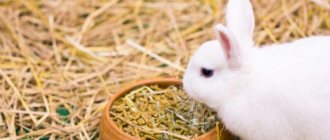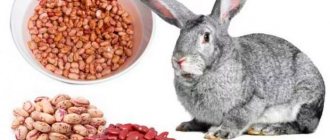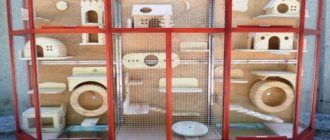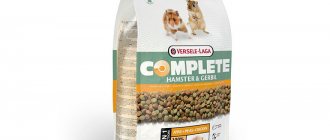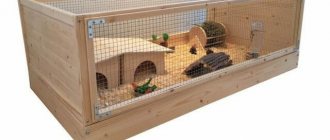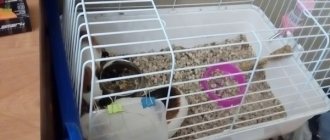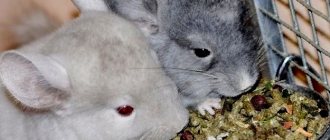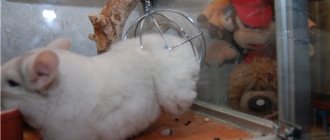A complete and balanced diet for a rabbit is the key to its health, beautiful fur and good weight. At the same time, the best diet for the animal will, of course, be the diet that is as close as possible to life in the wild: meadow grasses and fresh hay, grains and root crops, bark and young shoots of trees - everything that the rabbit’s digestion has adapted to over centuries of evolution. However, it is not always possible to provide the furry glutton with the necessary amount of fresh food, given his 40-80 meals a day; This problem is most often faced by owners of large rabbit farms, where it would take more than one haystack a day to feed the entire population. In addition, owners are often interested in gaining the animal’s body weight as quickly as possible, and feeding a rabbit with grass and hay is very problematic.
In this case, the optimal solution is a balanced feed for rabbits, the use of which significantly reduces labor and material costs for feeding them, and also ensures faster weight gain for the rabbit when it consumes less food.
This is what commercially produced rabbit feed looks like.
The importance of a balanced diet for rabbits
Rabbit breeding is one of the popular areas of domestic animal husbandry.
The main task of the breeder is to obtain healthy offspring and provide immunity to various infections and diseases. Nutrition is the main part of care and maintenance, since not only the improvement of fertility and live weight gain, but also the absence of many diseases, for example malocclusion, digestive disorders and other gastrointestinal diseases, depends on its correct balance.
Many sources indicate that rabbits are versatile animals and they can eat literally anything, but this is not true. The consequence of ill-considered feeding can even be fatal. Therefore, breeders should pay attention to this fact in order to increase performance for both industrial and ornamental breeds.
Automation of feed accounting and ration calculations
Large farms have long been using specialized software for automating feeding accounting and calculating rations. The development of modern technologies and the reduction in the cost of computers and software have led to the fact that now even medium and small farms can also afford such automation.
As one example of software where you can conveniently and quickly keep track of feeding and calculate rations, as well as production accounting and reporting for rabbit breeding, you can cite the “MATRIX” program. Rabbit breeding”, developed by specialists from the MATRITSA company from Belgorod.
Conclusion
In organizing the technological process on a rabbit breeding farm, of particular importance is the creation of a system of adequate feeding for them, capable of ensuring high growth rates of young animals and good reproductive abilities of adult livestock. In this case, it is necessary to pay attention not only to providing rabbits’ diets with energy and protein, but also to take into account the content of different fractions of carbohydrates, fat, macro- and microelements, and vitamins of various groups. Only such an approach to rationing rabbit feeding with an economically sound choice of different types of feed can ensure sustainable and highly profitable development of the industry. It is almost impossible to do this without the introduction of automated systems for calculating rations and recording feeding in rabbit breeding.
What types of feed are there?
Dry mixtures for feeding rabbits have a huge variety, but they all have a balanced composition that can provide all the needs of both babies and adults. There are several different directions in composition, which are focused on age, breed and type (for example, raised for meat or to obtain fluff).
In rabbit farming, there are three main types of feed according to their composition:
- Complete - intended for complete nutrition, usually only it is used, containing all the necessary elements to maintain a healthy condition of the rabbit. The marking is indicated by alphanumeric characters - PK-90-1 (letters - Complete Food, numbers - purpose, determining age, breed).
- Concentrated - goes as an addition to the general feed, has a high content of vitamins and protein supplements. According to the standard, it is marked K-92-2 or K-91-1, that is, concentrate.
- Feed additive - considered complementary food to the main food; the mixture formula contains only certain minerals, vitamins, and amino acids.
According to the standard, feed for rabbits is produced in accordance with the requirements of GOST 32897-2014.
We have developed our own food recipes for all types of animals:
- for newborns,
- for young animals,
- for adults,
- for pregnant or nursing females,
- for downy and meat rabbits.
Protein requirement
During the period of sexual quiescence, adult rabbits need about 12% of digestible protein in the dry matter of their diets. Replacement young stock also have a similar need for digestible protein. For females during lactation, males during mating, and young animals for fattening, protein nutrition standards are increased by 30-35%.
When rationing protein for rabbits, special attention must be paid to their amino acid nutrition. The role of amino acids in rabbit nutrition is very important. Lysine is used for the synthesis of tissue proteins. Arginine promotes the synthesis of urea and takes part in the formation of sperm, muscle creatinine, and insulin. Histidine is needed for the formation of hemoglobin and red blood cells. Tyrosine – for the formation of thyroxine and adrenaline. Cystine activates insulin and methionine and takes part in fat metabolism processes. Tryptophan – in the renewal of blood plasma proteins. In the body of rabbits, essential amino acids are not synthesized, and therefore, for normal life, animals must receive them with food. This applies to the greatest extent to rabbits raised for meat.
Nutritional value of compound feeds
These mixtures serve as the best and main source of protein, carbohydrates and various fats, they contain all the necessary nutrients for rabbits. According to the recipe, the optimal options for containing one or another component are selected, the breeder does not waste time calculating portions, and convenient packaging allows you to reduce the process of distributing food to a minimum.
Each composition was developed by specialists who monitored the correctness of the diet and the general recipe. It is the granules that retain the greatest nutritional value and allow you to avoid losses that occur during the separate distribution of components.
Requirement for minerals
Minerals play an important role in all metabolic processes in the body of rabbits. Females excrete a significant amount of them in milk. In particular, calcium - 1.32 g, magnesium - 0.7 g, phosphorus - 0.9 g, potassium - 0.43 g and sodium - 0.3 g per day. It should be taken into account that lactating rabbits produce twice as much milk per unit of live weight as cows and goats. As a rule, in feeding rabbits, the mineral saturation of the dry matter of feed is usually able to meet the needs of animals (with the exception of table salt). However, depending on the characteristics of the soil conditions of certain geochemical zones in which forage plants grow, a deficiency of mineral elements often occurs, which must be compensated in the diet. That is why, in feeding rabbits, as well as other species of animals, the correct determination of the chemical composition of feed is of great importance. It is better when such a determination is carried out on each individual feed sample in a laboratory setting.
Calcium and phosphorus are the main minerals in the body of rabbits, which account for 65-70% of the mass of feed ash. Calcium here is the main material for the formation of bone tissue. It is also part of the body's cells. Calcium metabolism is closely related to the functions of the endocrine glands. With its deficiency, the development of embryos, clouding of the crystals of the eyes, tetany, and osteomalacia are disrupted. These phenomena can be prevented by daily calcium supplementation at a level of 30-60 mg. Feeds rich in calcium include clover, alfalfa, vetch, as well as animal feed - meat and bone meal and fish meal. Phosphorus also forms the basis of bone tissue in rabbits. There is quite a lot of phosphorus in glandular tissues, muscles, nervous tissue, and phosphoric acid takes part in the metabolism of carbohydrates and fats. Lack of phosphorus in the body of rabbits leads to rickets, osteomalacia and other problems. Its optimal level in the dry matter of the rabbit diet is 0.144-0.164%. A lot of phosphorus is contained in bran and cakes.
Iron and copper . A special feature of rabbit milk is the almost complete absence of iron in its composition. There is a reserve of iron in the liver of newborn rabbits, but it decreases very quickly over time. Therefore, during the suckling period, rabbits may already be in an anemic state. The normal level of hemoglobin in the baby rabbit’s body is restored by daily feeding 2 mg of iron and 0.2 mg of copper. A lack of copper in the diets of rabbits is accompanied by hair loss, peeling skin and growth retardation. Feeds rich in iron and copper include meat and bone meal and blood meal.
Potassium and magnesium . Insufficient amount (0.3% or less) of potassium in the diet of rabbits is the cause of muscular dystrophy. The norm of potassium content in diets, which ensures intensive growth of rabbits, is 0.6-0.9% of the dry matter of the feed. At the same time, with a low (less than 30 mg per 100 g of feed) level of magnesium in diets, growth retardation, convulsions and death of rabbits occur. A preventative measure for magnesium deficiency can be the administration of 30-40 mg of this element as part of magnesium sulfate.
Manganese and sulfur . It is believed that 1 mg of manganese provides the daily requirement for rabbits, and 8 mg is already a toxic dose. Rabbits can use inorganic sulfur from sulfates.
Cobalt and iodine . The need of rabbits for iodine is ensured by its intake with food; however, this statement requires mandatory verification taking into account the geochemical zone where feed crops grow. Cobalt is found in willow and aspen leaves, legumes (clover, alfalfa, vetch) and root vegetables.
Salt . Table salt, which is part of the blood, cells and tissues of their body, is of great importance for the normal functioning of the body of rabbits. A lack of salt in diets causes loss of body water, a decrease in the growth energy of animals and their milk production, as well as the efficiency of feed use. In the practice of rabbit breeding, it is accepted that young animals need 0.5 g of table salt per day, adult rabbits - 1-1.5 g, and females during pregnancy - 1.5-2.0 g. Complete granulated food for rabbits contains salt. include in the amount of 0.5-1.0%.
Advantages and disadvantages of feeding rabbits with compound feed
The use of mixed feed has many advantages:
- saving time - when distributing food, a minimum of time and effort is spent;
- easy calculations - determination of the daily norm (regardless of the age of the rabbits) occurs quickly;
- full balance - in the process of taking it, health improves, the animal’s immunity becomes more resistant to various infections and diseases. In addition, finished meat and skins, as a rule, have excellent characteristics and performance;
- prevention - the presence of vitamins and mineral supplements in the composition is aimed at preventing morbidity;
- guarantee - rabbits will gain weight in a timely manner and look healthy;
- cost reduction - no need to prepare a lot of hay and vegetable stocks, since they are already included in the general composition of the feed;
- ease of use - does not require special storage conditions, comes in convenient bags that are easy to transport.
You should also pay attention to some disadvantages, the main one of which is low-quality food, which is most often produced by cost-effective manufacturers, adding synthetic components and various flavor enhancers, thereby reducing its cost. The recipe may contain medications that greatly affect the taste and animals may refuse to eat it.
Another problem for breeders is the high price, but it is better to pay attention to the composition and pay more than to lose the entire livestock in the future. Another problem is the transfer of animals from fresh food to dry food or vice versa - disturbances occur in the digestive tract.
Rabbit food
To properly feed rabbits, you need to know the nutritional value of feed and its digestibility. Here it is also necessary to take into account that the digestibility of feed depends on its quality and the physiological state of the animals. In livestock farming practice, all feed is conventionally divided into four groups: coarse, juicy, green and concentrated. In addition, mineral and vitamin supplements and industrial waste (dry pulp, cakes, meal) are used in rabbit farming.
Green food is the main food for rabbits in the summer, both when kept in cages and when kept in shad. In terms of biological value, green feed has no equal, as it contains the entire range of essential nutrients. Chlorophyll from green feed also takes part in hematopoietic processes. Such feeds differ greatly in chemical composition and nutritional value, and contain 60-80% or more moisture. The dry matter of green mass, mowed in the optimal phase of the growing season, is close in nutritional value to concentrated feed, but its biological value is significantly higher. On average, the dry matter of such green feeds includes 20-25% digestible protein, 10-15% fiber, 4-5% fat, 30-60% nitrogen-free extractives and 9-11% minerals.
Of the sown grasses, the most valuable food for rabbits are legumes (clover, alfalfa, sainfoin, peas, vetch-oat and vetch-pea mixtures). Rabbits are also good at eating cereal plants (winter wheat, rye, oats, corn) that are mowed before the heading stage. The green conveyor is designed in such a way that during the spring-summer and autumn periods of the year, green feed is constantly supplied to the rabbit farm in the required quantity.
Succulent feeds (root tubers, melons and silage) with a combined type of feeding rabbits in terms of nutritional value occupy up to 30-50% of the diet in the late autumn, winter and spring periods of the year. Among them, rabbits are fed carrots, potatoes, sugar beets, turnips, rutabaga, and melons - zucchini, pumpkin, and watermelons. Root tubers contain a lot of water and little protein, minerals, fat and fiber. The dry matter of these feeds consists of easily digestible carbohydrates, mainly sugar.
The best succulent food for rabbits is red carrots, 1 kg of which contains up to 250 mg of carotene, 0.62 g of calcium and 0.5 g of phosphorus. Sugar beet tops are unsuitable for feeding rabbits because they contain a number of organic acids (oxalic, malic, etc.). They can cause digestive disorders in rabbits, especially young ones. Potatoes are usually given to rabbits steamed, but the water must be drained to prevent solanine poisoning. Silage is fed to rabbits only of the highest quality, without signs of mold.
Among the roughage for feeding rabbits, hay is used, which is an important source of protein, vitamins and minerals. Small-stemmed, leafy hay from forbs collected at optimal times during the growing season contains 15-18% water, 8-9% digestible protein, 1-2.5% fat, 40% nitrogen-free extractives and 25-28% fiber. Straw, both cereals and legumes, are not used to feed rabbits.
The above-mentioned feeds (green, rough and juicy) form the basis of diets, but do not provide high growth rates for rabbits, because there is an insufficient amount of energy and nutrients per unit of their natural mass. In this regard, it is impossible to properly balance the diets of rabbits without concentrated feed . The level of use of this type of feed in the technological process directly determines the intensity of the rabbit breeding industry. Depending on the chemical composition, grain concentrates are divided into two types - carbohydrate and protein. Carbohydrate concentrates include cereal grains (oats, barley, corn), protein concentrates include legume grain feeds (vetch, soybeans), as well as cakes, meal and bran, animal feed, and feed yeast. Grass meal is of great importance in feeding rabbits, especially when switching rabbit farming to dry feeding. Herbal meal contains 10-12% water, 17-20% digestible protein, 2-3% fat, 35-40% nitrogen-free extractives and 20-22% fiber.
As part of animal feed for feeding rabbits, dry skimmed skim milk, meat and bone meal and fish meal are used. The main feature of animal feed is that it contains no fiber at all. They consist mainly of protein, a small amount of fat, sugar (in milk) and minerals. It is advisable to introduce such feeds into the diets of nursery and suckling females, replacement and fattening young animals. Feeder yeast contains biologically complete protein, a complex of vitamins B, and, when exposed to ultraviolet irradiation, vitamin D.
A special place in the group of concentrated feeds is occupied by compound feeds, the components of which include ground or crushed grain of cereals and legumes, animal feed, grass flour, industrial waste (cakes, meal, etc.), as well as vitamins. mineral premixes. Formulated feed recipes for rabbits are developed based on data on the rationing of their feeding depending on the physiological state, age and type of feeding.
Is it possible to feed only mixed feed?
Compound feeds are introduced into the diet along with grains, and then only dry mixtures are gradually removed. Thanks to the good balance of the composition, it is possible to adjust the nutrition, taking into account the total daily requirement and observing the animals.
The general recipe contains everything a rabbit needs - all types of feed in concentrated form, mineral supplements, vitamins. Some mixtures contain probiotics and medications, which can help prevent a variety of diseases. Therefore, by choosing mixed feed as the main food, the breeder will receive the correct development of individuals and guaranteed weight gain.
Fat requirement
In adult rabbits and young animals, the standard requirement for fat is almost completely satisfied by its intake with food. Rabbit milk has a very high fat content (15-18%), which is 4-4.5 times higher than the fat content of cow's milk. In this regard, it is necessary to control the fat content in the diets of rabbits, especially young animals reared at an early age. It has been established that young rabbits develop poorly if the dry matter of the diet contains less than 5% crude fat.
Recommendations for daily diet
Like other animals, in rabbits the calculation of the daily norm depends on several factors - breed, gender, time of year, age:
- young animals - from one and a half to two months 140 g, from 2 to 3 months 205 g, from 3 to 4 - 280 g, after 4 months 200 g per day is considered the standard;
- uterine females - while at rest consume 170 g per day, during the mating period 230 g, pregnant women 170-180 g;
- lactating females - as the offspring grow, she needs more and more feed; on average, it is believed that a rabbit with 5-7 babies needs from 230 to 700 g of feed.
It should also be noted that meat breeds eat more than fur breeds. The number of servings is distributed according to age - babies are fed fractionally, up to six times a day, and adult animals 2-3 times.
Features of digestion in rabbits
Proper feeding of rabbits is impossible without knowledge of the peculiarities of their digestion. Rabbits have a fairly developed gastrointestinal tract, the length of which is 9-10 times greater than the length of the body. Moreover, only the thin section has a length of 3-4 m. Rabbits have a well-developed cecum, and its volume is 7-8 times larger than the stomach.
Digestion of nutrients in rabbits begins in the oral cavity, where the food is mechanically ground and moistened with saliva containing the enzyme diastase. Under its action, the starch of the feed turns into sugar. From the mouth, food enters the stomach. In it, under the action of the enzyme pepsin and hydrochloric acid, feed proteins are broken down into albumoses and peptones. It should be noted that the enzymatic activity of gastric juice in rabbits is significantly higher than in other herbivorous domestic animals.
From the stomach, the food mass is pushed into the duodenum, where further digestion of nutrients occurs. Under the influence of pancreatic enzymes, intestinal juice and bile, all nutrients in the feed are broken down - proteins, fats and carbohydrates. In the small intestine, breakdown occurs to amino acids, monosaccharides, glycerol, and fatty acids. Then they are absorbed into the blood and distributed throughout the body. Water and microelements are also absorbed in the small intestine. The digestion of food nutrients is completed in the large intestine (cecum, colon and rectum). In the cecum of rabbits, the digestion of nutrients ends, and fiber is also fermented.
The digestion of rabbits differs from other domestic animals by the presence of the act of coprophagy - eating their own soft feces. As a result, the rabbit’s body receives some of the nutrients that were not absorbed during their passage through the gastrointestinal tract. This feature is an important biological adaptation of the species to the harsh environmental conditions in which rabbits were before domestication (severe frosty winters, dry summers, etc.). However, the large intestine in rabbits is underdeveloped, so they do not effectively use high-fiber feeds.
How to do it yourself (technology and required equipment)
You can make compound feed yourself, but this will require you to spend a lot of time and be prepared for large financial expenses. First of all, there is a special table that lists all the components of a necessary and complete diet. You will need to stock up in advance on a large number of different products and supplements - grains, hay, legumes, sunflower seeds, yeast, various types of fish and bone meal, vitamins, mineral supplements, salt, chalk.
To create the mixture, you will need special equipment in the form of a chopper and a hay crusher, a mixer or a drill attachment for stirring the mixtures, as well as a meat grinder or feed granulator, and a dryer. To begin with, everything is crushed, mixed until a homogeneous mass is obtained, and then adding water, it is sent to a meat grinder or granulator. The resulting pieces are dried - the food is ready.
The main problem with homemade food is its short shelf life (no more than 10 days). It deteriorates quickly and requires certain conditions.
The whole process is quite long, it takes a lot of time, effort, and money, so the best solution would be to purchase ready-made feed and free up your time for something more interesting.
Composition of complete grain feed
Not only adult animals, but also young animals, as well as females during pregnancy and feeding their young, should be provided with everything necessary for development. That is why purchased mixtures differ slightly in their composition and percentage.
You will find photos of the Rex breed in this article.
Basically, such mixtures are labeled accordingly, so before purchasing it would be useful to consult the seller. Among the variety of ready-made foods, PC has the most positive reviews for use – 90.
The composition of this feed is very diverse and is ideal for feeding young animals from the age of one month.
Composition of feed PK – 90:
- Corn.
- Wheat.
- Soybean meal.
- Sunflower seed.
- Herbal flour.
- Complex of vitamins A, D3, E, P, K3, PP and group B.
- Amino acids.
- Salt.
- Micro and macroelements: calcium, sodium, iron, magnesium, phosphorus, copper, cobalt, selenium and many others.
- Multienzyme composition.
The content of nutrients is as balanced as possible and is suitable specifically for raising rabbits. Energy value - 237 kcal/100 grams of product. The food is easily digestible and readily eaten by pets. In addition, its delicate structure does not irritate the sensitive digestive system of animals. This is why you should not buy feed for rabbits that is intended for feeding other animals.
We recommend that you familiarize yourself with the New Zealand breed in this material.
If your number of rabbits is not too large, purchasing special feed will not “hit” the family budget, but for mass breeding of meat breeds, the amount of costs will increase significantly. To save money without sacrificing quality, you can start making your own feed at home. The information below will tell you how to do this as successfully as possible.
You might also be interested in the chinchilla breed.
How to feed
Every rabbit breeder must monitor how animals eat and respond in a timely manner to emerging situations. It is common to eat only certain granules; the animal chooses only those pieces that it likes the most, and the most useful ones remain in the bowl. In this case, you must wait until the food is completely eaten and only then add the next portion.
If this happens constantly and some of the food remains in the feeder, then you need to reduce the daily norm, perhaps it is too high, or vice versa, the rabbits eat the mixture very quickly, then you need to slightly increase the weight of the portion.
In summer, the calculated norm is slightly less than in the cold period.
It is necessary to have water in the drinking bowl; it should always be fresh and clean, as well as in sufficient quantity.
Each package of feed for breeders contains all the information - who the mixture is intended for, what age it is intended for, average consumption rates and general recommendations for breed and weight.
If desired, in the summer, breeders often give preference to fresh grass and vegetables, but still use concentrated mixtures - they should be at least 20% of the total diet.
Video
This video will tell you how to make food for rabbits at home.
Homemade feed should not be stored for more than a month, and since its production will depend entirely on you, the costs of its transportation are reduced, and the quality will always be consistently high. All these simple rules will help make raising rabbits an even more profitable business and make it easier to regularly care for these fastidious animals. The video “rabbit breeding for beginners” is presented at the provided link.
Useful tips from MEGAMIX
The average calculation of daily feed for rabbits is per 1 kg of live weight and is 30-40 grams. A common addition to dry formulas is water and hay.
If desired, you can sometimes add grass, beets, leftovers from the beds and garden, and some grains to the diet.
Many breeders believe that any type of food is suitable for rabbits, even chicken or pork, but we should not forget the health features of these animals: often too much protein and improper consistency have a very detrimental effect on the health of the animal. Bird food often contains sand and shells, which are generally not suitable for rabbits.
All rabbit breeders should know that in no case should chocolate (this is the most toxic product for them), any cookies, potatoes, bakery and flour products, as well as any food from the table get into the animals' hands - this will only cause harm. It is better to give berries and fruits (up to 3 times a week), vegetables - up to three different varieties, and it is better to prefer greens rather than root vegetables.
The best food from manufacturers
Today there are a large number of products on the rabbit food market, but the most popular are the following products:
- “Multigane” for rabbits - the company produces complete, balanced food concentrates based exclusively on natural compounds. The company's products do not contain harmful hormones and antibiotics, therefore they 100% meet modern environmental requirements, while containing all the necessary substances for productive breeds. This food has one of the best price/quality ratios due to the presence in its composition of the optimal amount of vitamins, micro- and macroelements, as well as energy compounds useful for gaining weight.
- Feed&Life PC 92-1/24 is a complex of balanced feed that meets premium standards. They are rich in both vitamins and amino acids necessary for optimal body development. The main distinguishing quality of the company is the development of highly targeted products needed during certain periods of an animal’s life. That is why Feed&Life products satisfy all production needs when raising fur-bearing animals.
- Purina, a universal food for rabbits, is a non-professional extruded food for small and medium-sized farms. It contains all the most important components for the development of animals from birth to maturity. The main highlight of the product is the maximum complete content of nutrients, so the use of food makes it possible to refuse other additives, including vitamin preparations.
- PROVIMI for rabbits is a supplement based on natural ingredients selected according to the principle of the highest biological susceptibility. That is why even a small amount of this product in the diet of animals makes it possible to improve their immunity, as well as increase the productivity of the farm. In addition, it contains only high-quality plant compounds, so this food can provide rabbits with the healthiest diet possible.
- Bnl Grain Free rabbit is a grain-free food for animals of all ages. It consists of granular components, the basis of which are field and meadow grasses. Most often, such products are used in winter in all kinds of dry mash. They make it possible to completely eliminate the rabbits’ deficiency in green grass, which helps increase immunity and digestibility of other foods.
